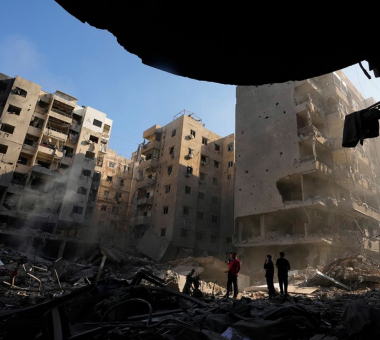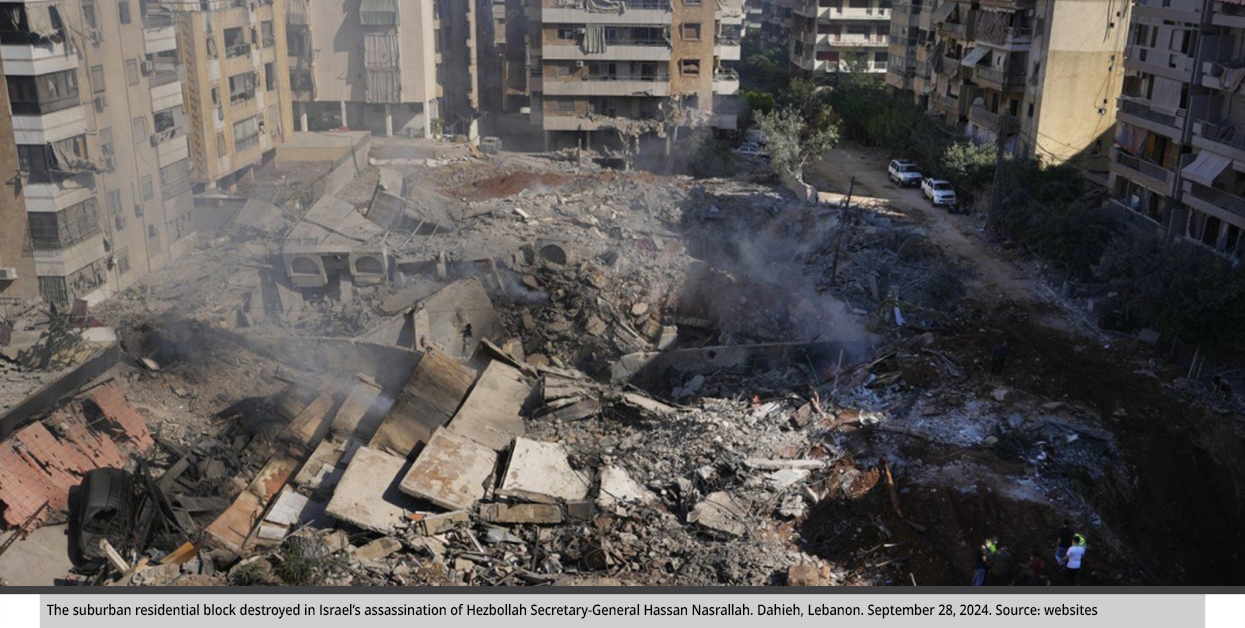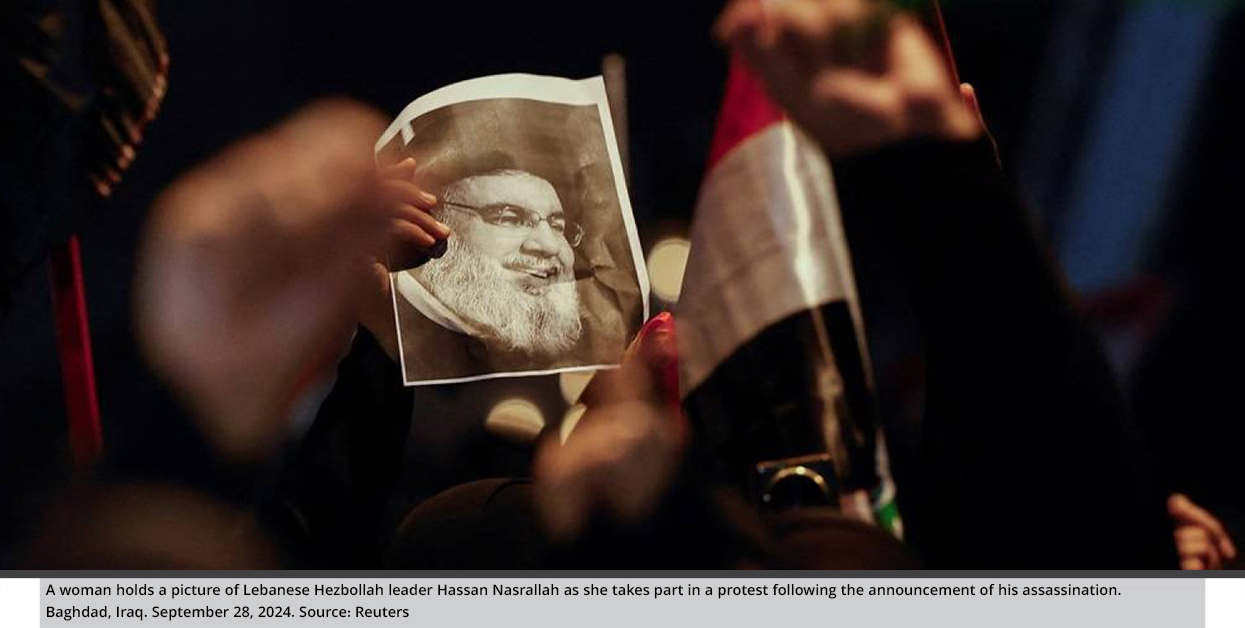Nasrallah’s Assassination Puts Hezbollah and the Unification of the arenas in a Critical Moment
The assassination of Hezbollah Secretary-General Hassan Nasrallah puts the movement in a critical moment, exacerbating the damage to its military structure. This raises questions about Hezbollah’s position in confrontation with Israel, the Iranian approach toward its most important allies, and the stance of the other parties in the “Unification of the arenas.”
by STRATEGIECS Team
- Release Date – Sep 29, 2024

Israel’s assassination of Hezbollah Secretary-General Hassan Nasrallah on September 27 marks a critical moment for the movement now caught between regaining its balance or immediately responding to the Israeli campaign to remove Lebanese Hezbollah as a force in the region. In addition to its leader Nasrallah, the air strike also killed more than 20 other Hezbollah leaders, including its third-ranking commander, Ali Alkararki, as well as a number of leaders of Iran’s Islamic Revolutionary Guard Corps, such as its deputy commander, Abbas Nilforoushan.
Israel employed 85 bunker-busting bombs, each weighing a ton and capable of penetrating down to 230 feet underground. Only hours before the attack began, Israeli Prime Minister Benjamin Netanyahu warned world leaders at the United Nations that Israel “will continue degrading Hezbollah until our objectives are met.” This raises urgent questions about Hezbollah’s position in the confrontation, Iran’s approach towards one of its key allies, and the responses from other parties in the “Unification of the arenas.” The answers hinge on the nature of the forthcoming reactions to Nasrallah’s assassination.
Hezbollah’s Current Ground Position
Hezbollah currently faces a critical moment, with significant damage to its military, leadership, and security structures. Despite the stark contrast in military strength between Hezbollah and Israel, Israeli assessments have consistently pointed to worst-case scenarios in the event of a large-scale war, particularly concerning Hezbollah’s potential targeting of strategic civilian and military sites such as ports, airports, and energy facilities. In June 2024, Shaul Goldstein, head of Israel’s electric company, Noga, warned that Hezbollah could easily disrupt the Israeli power grid. These concerns stem from Hezbollah’s well-armed and trained status, coupled with its superior firepower compared to Hamas, as highlighted by Israel’s experiences in the 2006 Israel-Hezbollah war.
However, contrary to expectations, Hezbollah has shown a notable weakness in responding to the recent series of strikes that killed high-ranked commanders and destroyed missile and weapons storage locations. Theses strikes appears to have taking Hezbollah by surprise and put it under great pressure to address the gaps in its ranks, particularly after discovering the depth of Israeli intelligence superiority and the extensive vulnerabilities in its structure.
Additionally, these strikes dealt a psychological and morale-deflating blow to Hezbollah, complicating its ability to declare war or frame the situation as a breach of the threshold for conflict. This was evident in Nasrallah’s last public appearance, on September 19, in which he maintained a stance of controlled escalation. Despite this, the series of Israeli strikes following the July 30 assassination of Fuad Shukr, a founding member of Hezbollah’s armed wing, along with the September 17 and 18 targeted explosion of hand-held communication devices that killed 20 and injured 450 people, and the September 20 bombing that all but wiped out the leadership command of Hezbollah’s elite Radwan unit, indicated that Israel had surpassed its initial objectives of returning settlers to northern settlements and had begun expanding its strategy toward achieving a strategic resolution on the Lebanese front.

Israel’s Attempts to Separate the Center From the Units
The current scene is characterized by intense and consecutive strikes, leading to a paralysis within Hezbollah system and a void in its leadership. The Israeli strike that killed Nasrallah also destroyed the movement’s main command center, causing communication breakdowns between the center and the units that left thousands of fighters in the field without guidance. It remains uncertain whether Hezbollah has regained central control over its branches and units. Restoring control and absorbing losses, especially in a post-Nasrallah transitional phase, would typically require periods of calm or a ceasefire. However, the Israeli understanding of these dynamics makes a ceasefire highly questionable. Indeed, Israel firmly rejected a U.S.-backed proposal for a 21-day ceasefire while intensifying pressures on Hezbollah.
- Disrupting Hezbollah’s social structure: Following the assassination of Nasrallah, orders were issued, for the first time, to evacuate areas in Dahieh, a predominately Shia Muslim suburb in southern Beirut.
- Closing off avenues that could help Hezbollah restore its strength in leadership and equipment, particularly in terms of Iranian support both aerially and on the ground: On September 28, the Israeli army carried out airstrikes on military infrastructure at the Syrian-Lebanese border and announced a military blockade on Lebanon.
- Removing Hezbollah fighters from the Lebanese-Israeli border: Indications are increasing that the Israeli army is carrying out ground operations that will lead to the establishment of a secure buffer zone up to the Litani River.
On the other hand, placing the Hezbollah in a position of existential risks regarding its strength and its projects may compel it to test its ultimate capabilities to confront Israeli strikes. This could be driven by changes in its leadership structure, especially if Hashem Safieddine, who has strong influence and close ties with Iran, succeeds Nasrallah. Additionally, unexpected attacks might be carried out by armed cells acting outside the Hezbollah’s central command.
Hezbollah appears to need broader participation from other factions in the “Unification of the arenas,” which since the outbreak of the war on October 7, 2023, has adopted a strategy of geographic distribution of military efforts to alleviate pressure and prevent any single arena from facing the Israeli or American military momentum. This is essentially what Hezbollah is currently facing.
Therefore, the reaction from Iran and its proxies to the recent Israeli attacks in Lebanon should transcend the norms of retaliation, as Israeli assaults may extend to other fronts beyond Lebanon. As Netanyahu promised Iran in his September address before the United Nations: “If you strike us, we will strike you. There is no place in Iran that the long arm of Israel cannot reach—and that’s true of the entire Middle East.” In addition, the Israeli army warned the Houthis, “Your time will come.” This compels Iran and its proxies to consider that any response must elevate to a level of deterrence, imposing costs on Israel that will prevent it from carrying out its strikes with the same ease as with Hezbollah.
The Nature of the Responses After the Assassination of Hassan Nasrallah
In fact, after recent events, Hezbollah, Iran and other members in the “axis of resistance” face three options.
First: Maintaining self-restraint
In this option, Hezbollah and other members of the “Unification of the arenas” keep the current level of confrontation, in which Hezbollah manage the battle individual without wide participation of Iran, the Houthis and the Iraqi factions. On one hand, it does not seem that Hezbollah is able to respond proportionately to Nasrallah assassination, and on the other hand, the other parties would fear the Israeli retaliation against them. Additionally, Iran might prefer not to respond to prevent giving Israel the opportunity to drag them into a regional war that could involve the U.S. in defensive and offensive roles, especially since Israel shows considerable readiness to respond disproportionately to any attacks against it.
Moreover, the Israeli attacks in Syria and Lebanon significantly weakened Iran ability to support Hezbollah or to act from the other arenas against Israel. However, despite the damage to Hezbollah’s leadership and security structure, it is possible that Hezbollah would wait to an Israeli ground incursion into Lebanon to rebuild its image. Such incursion could enhance the activity of the combat formations in the field, which are estimated to number in the thousands. This suggests that Hezbollah is looking to preserve as many capabilities as possible for long-term rebuilding, while Iran seeks to maintain its core and prevent damaging it as its proxies get damaged .

Second: launching precise missile strikes against cities in Israel
This includes Hezbollah targeting Tel Aviv with a missile it launched for the first time named “Qader 1” on September 26, as well as targeting a settlement near Jerusalem with a long-range missile on September 28.
Likewise, a response from the Houthis and Iraqi factions is likely. The Houthis launched a ballistic missile that penetrated air defenses and landed in Kfar Daniel, a village near Ben Gurion Airport, while a drone launched by Iraqi armed factions exploded at an Israeli military base on September 24. This indicates that the parties of the “Unification of the arenas” are still capable of executing complex attacks that surpass Israeli air defenses and reach their targets.
However, such attacks may not alter the deterrence equation that has begun to favor Israel nor are they likely to halt the depletion of Hezbollah’s capabilities or lead to significant changes in the ongoing battle in Lebanon or reach the level of declaring an open war.
Third: taking actions that align with the nature of the Israeli attacks
If taken by Hezbollah, Iran, or others, this option could escalate to a state of war involving a series of strikes that exceed the normal responses and target strategic installations that result in economic losses and damage to civilian and military infrastructure. Iran would play a central role based on its delayed response to Israel’s July 31 assassination of Ismail Haniyeh, the head of the Hamas political bureau, which became less important in light of the subsequent events, along with the significance of Nasrallah and Hezbollah in the Iranian regional politics. Iran’s response is expected to send a message to other members of the axis regarding Tehran’s capabilities in defending them.
However, if the eternal political calculations in Iran prevent it from responding to the unprecedented Israeli attacks against Hezbollah, other parties may conclude that the Iranian strategy is shifting from a closely linked strategic and ideological relationship based on Iran’s national security to a more transactional relationship governed by events and their developments.
Additionally, this option may be the only one available to the parties of the “Unification of the arenas” to restore deterrence fully and bring the region closer to an impending regional war, clarifying the repercussions of continued Israeli attacks and exerting pressure on the United States, which will hold its presidential election in November.

STRATEGIECS Team
Policy Analysis Team
 العربية
العربية